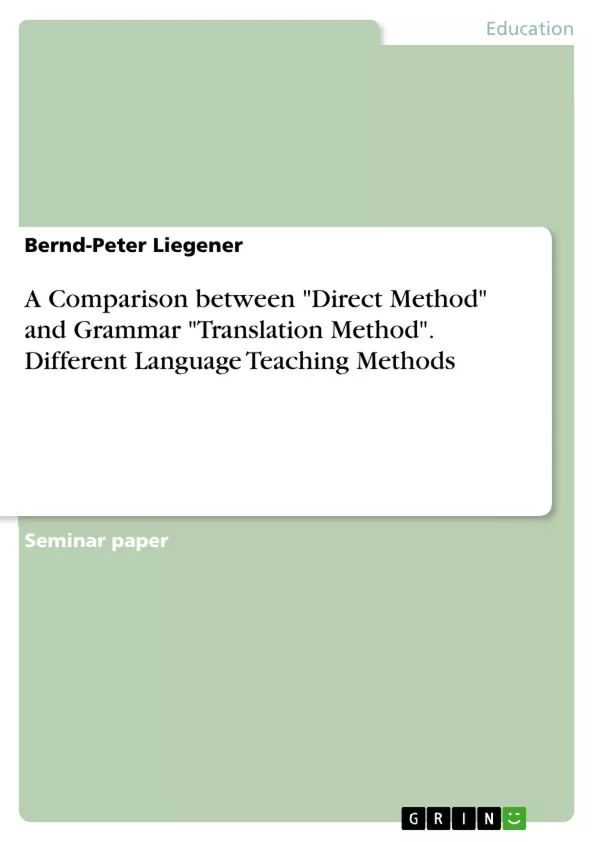Two methods of teaching foreign languages, the “Direct Method” and the “Grammar Translation Method” are described and compared. The underlying principles with main focus on acquisition of communicative skills and grammatical knowledge respectively are illustrated. Looking at possible results of either method we find that there is no gradual difference between them in the sense of better or worse, but that both have completely different targets. The suggestion is made to combine different methods in order to achieve multiple goals and to vary the emphasis according to individual goals.
The most ancient and probably most fundamental controversy in language teaching is the one between “Direct Method” and “Grammar Translation Method”. Both of these have totally different underlying approaches. For interested educational stakeholders or educators, there are two important questions, they should think of before looking for an appropriate method: What do I want the students to achieve? How can the learners reach this goal? One can think of different goals which should be reached by teaching a language and every teacher will want to cover most of them in their teaching. The emphasis however is very divers between the different approaches that have been developed over the years. And the most apparent difference, a completely different idea of how to teach language shows up between the two mentioned methods and their approaches respectively. This is why it is so interesting and exciting to compare these two methods and this is why I will try to tackle that task in this paper.
The first and main goal of teaching a language obviously is teaching the language. But here rises already the first question: What is the language that we want the learners to learn? Are we talking about skills in oral or written language? Is our focus more on active or passive language i.e. on speaking and writing or listening and reading respectively? Are we concerned about correctness or fluency? Does correctness mean formulating grammatically correct sentences or texts, does it refer to perfect pronunciation and intonation, are we talking about style aptly adapted to the contextual situation? And does fluency have to do with the speed of writing or speaking, with the ability to develop own ideas and own formulations while speaking or writing rather than using memorized phrases? Or do we want the learners to know about the language, understanding its structure, its roots, its development?
Table of Contents
- Introduction
- Goals of language teaching
- Language related goals
- Other goals of language teaching
- Goals of DM and GTM with regard to language acquisition
- The Direct Method
- Development of the Direct Method
- Features of the Direct Method
- Language related goals of the Direct Method
- Advantages and disadvantages of the method
- The Grammar Translation Method
- Development of the Grammar Translation Method
- Features of the Grammar Translation Method
- Language associated goals of the Grammar Translation Method
- Advantages and disadvantages of the method
- Comparison of the outcome of the two methods
- Goals of language teaching beyond language acquisition
- The Direct Method
- Interactions in the classroom
- General education goals of the Direct Method
- The Grammar Translation Method
- Interactions in the classroom
- General education goals of the Grammar Translation Method
- Comparison of the outcome of both methods with regard to general education goals
- Conclusion
Objectives and Key Themes
This paper aims to compare two prominent methods of foreign language teaching: the Direct Method (DM) and the Grammar Translation Method (GTM). The paper explores the historical development, core features, and language-related goals of each method. It examines the advantages and disadvantages of each approach and analyzes their potential outcomes regarding both language acquisition and broader educational goals. The paper concludes with a comparison of both methods and suggests a combined approach for achieving diverse learning objectives. * **The Historical Development and Principles of DM and GTM** * **The Language Acquisition Goals of Each Method** * **The Advantages and Disadvantages of DM and GTM** * **The Outcomes and Effectiveness of Both Methods** * **The Potential of Combining DM and GTM**Chapter Summaries
1. Introduction
The paper begins by introducing the long-standing debate between the Direct Method and the Grammar Translation Method in language teaching. It emphasizes the fundamental differences in their underlying approaches and highlights the importance of identifying learning goals and choosing suitable methods.2. Goals of language teaching
This section outlines the diverse goals of language teaching, encompassing both language-related objectives and broader educational aims. It explores various aspects of language acquisition, such as oral and written skills, active and passive language, correctness, fluency, and linguistic understanding. It also addresses the importance of teaching thinking skills, learning strategies, social behavior, motivation, values, ethics, and cultural knowledge.3. Goals of DM and GTM with regard to language acquisition
This chapter delves into the specific goals and characteristics of the Direct Method and the Grammar Translation Method regarding language acquisition. It discusses the historical development of both methods, outlining their key features and language-related objectives. The section also explores the advantages and disadvantages associated with each method.4. Goals of language teaching beyond language acquisition
This section examines the broader educational goals of the Direct Method and the Grammar Translation Method, focusing on their potential impact on student interactions, general education goals, and overall learning outcomes.Keywords
This paper delves into the world of language teaching, focusing on two prominent methods: the Direct Method and the Grammar Translation Method. The discussion explores the historical evolution, core features, language-related objectives, and comparative effectiveness of each approach. Key concepts like language acquisition, communicative skills, grammatical knowledge, educational goals, and potential for combining methods are central to the analysis.- Citar trabajo
- Bernd-Peter Liegener (Autor), 2017, A Comparison between "Direct Method" and Grammar "Translation Method". Different Language Teaching Methods, Múnich, GRIN Verlag, https://www.grin.com/document/445397




